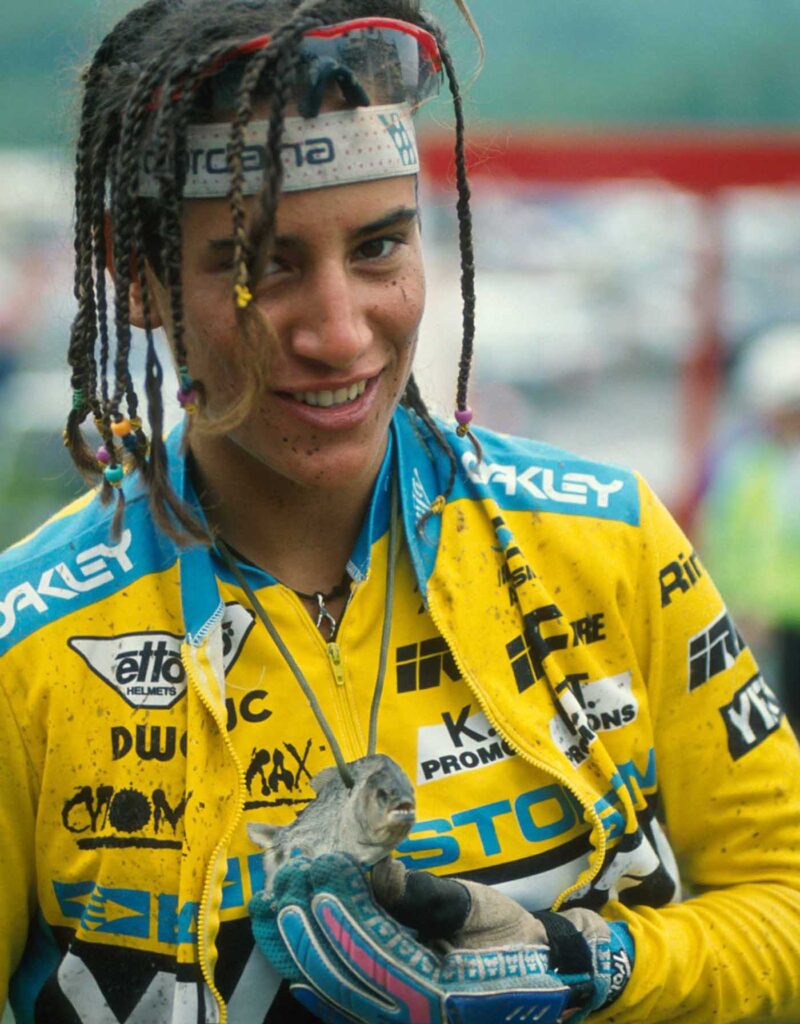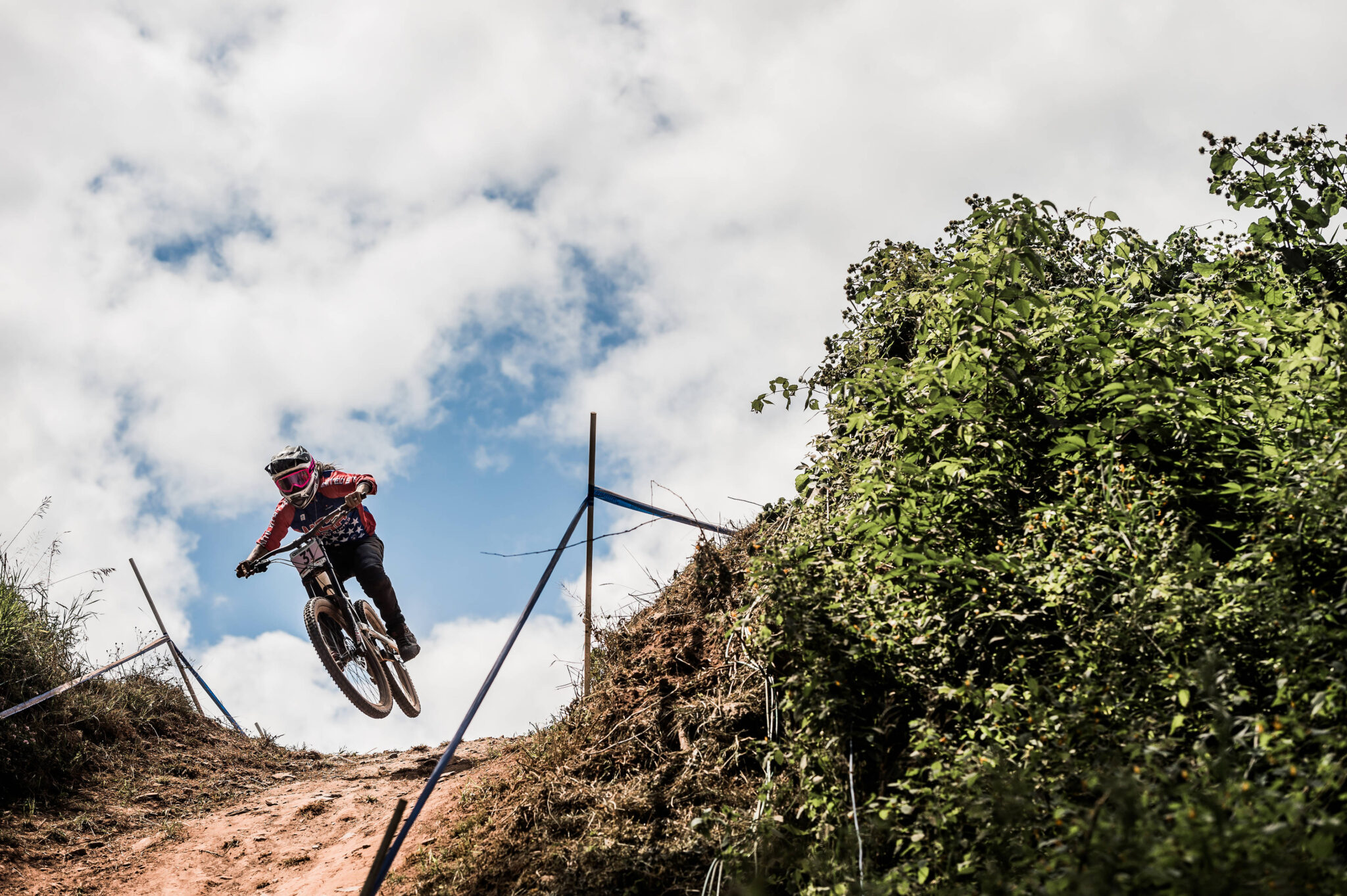The Queen of Downhill Mountain Biking
Updated 5/7/2025- Editor’s Note: Much of the original information in this article was compiled using publicly available sources. Since its publication, we’ve had the opportunity to speak directly with Missy Giove. As a result, we’ve updated certain sections to reflect new insights and verified facts from that conversation.
 Words by Beka Stephan
Words by Beka Stephan
When people talk about the highest-paid mountain bikers in history, the conversation usually centers around the modern-day giants: Aaron Gwin, Greg Minnaar, and Loic Bruni—athletes backed by global bike brands, stacked with podium bonuses, and spotlighted in slick video edits. But rewind a few decades, and one name stands out not just for speed and dominance, but for rewriting the rulebook on what it meant to be a pro rider: Missy “The Missile” Giove.
Long before downhill mountain biking was packaged for Red Bull TV and polished for Olympic audiences, Giove was already raking in serious cash and commanding serious attention. In the 1990s and early 2000s, she wasn’t just one of the best riders on the circuit—she was one of the most bankable athletes in all of extreme sports. According to The New York Times, her income exceeded her competitors’ by more than tenfold, thanks to big-ticket sponsorships, massive race wins, and an unmatched ability to command the spotlight. Missy Giove wasn’t just racing—she was setting the bar for what top-paid mountain bikers could look like.
Style, Substance, and Gonzo the Piranha
Giove was impossible to miss. Her wild hair, aggressive riding style, and a dried pet piranha named Gonzo strapped around her neck made her equal parts athlete and spectacle. She wasn’t just fast; she was a force of nature, a walking disruption in a sport that still leaned heavily on buttoned-up professionalism and quiet humility. Giove was loud, proud, and openly gay, a rarity in the sports world at the time, let alone in the still-conservative realm of cycling.
She smashed stereotypes with the same reckless abandon she applied to race courses, injecting color, chaos, and charisma into every scene she entered. To her fans, she was a fearless icon who flipped the script. To critics, she was wild, unpredictable, and maybe a little unhinged. But even the haters couldn’t deny her raw talent or her mountain of results.
A Race Résumé for the Record Books
Giove’s career stats are the stuff of legend. She claimed:
- 14 NORBA national downhill titles (the most in history)
- 11 UCI World Cup victories, placing her fourth on the all-time list
- 3 NORBA overall downhill crowns
- 2 World Cup overall titles
- And the coveted 1994 World Championship title
She brought flat-out aggression to every race run and regularly pushed the boundaries of what bikes—and bodies—could withstand. But that fearlessness came at a cost. Giove endured over 40 broken bones, at least 10 concussions, and a brain hemorrhage following a brutal crash at the 2001 World Championships in Vail. The day before the race, she knocked herself out during practice and dislocated her shoulder. Against all odds—and medical advice—she still raced. Midway through her run, she went over the bars again. This time, the damage lingered. Months of headaches, blurry vision, and excruciating pain followed.

Retirement, Risk, and a New Kind of Adrenaline
By the time she retired in 2003, Giove had racked up nearly every accolade downhill could offer—but not much of a post-race plan. With no health insurance, no steady income, and zero interest in sitting through marketing meetings or selling energy bars at trade shows, Giove turned to something that felt a little more familiar: danger.
She entered the illegal cannabis trade, starting small with a 40-pound delivery and quickly scaling into full-blown trafficking. For someone already comfortable with risk, the transition wasn’t exactly a leap. Her fame offered a surprisingly effective disguise—after all, who would suspect a former World Champion was hauling weed cross-country in locked trailers?
Giove clocked thousands of miles, delivering top-shelf California cannabis to dealers across the country. She collected cash from backyard garbage cans in the suburbs. She rode dirt bikes into the woods to meet growers. With each trip, the stakes got higher—runs sometimes netted over $30,000, and the quantities ballooned into the hundreds of pounds.
The Fall: A Federal Bust with Gold Bars and Bad Puns
In 2009, the operation crumbled. One of Giove’s drivers—a 26-year-old woman paid $3,000 per trip—was stopped by Illinois State Police. She confessed everything to the DEA, explaining she’d made multiple runs from California to New York. Each time, she’d meet Giove at a Barnes & Noble parking lot, hand over the truck and trailer, and watch it disappear to a secret stash site.
The DEA planted a tracking device inside the trailer wall and let the next run roll. When Giove arrived at a kayaking center in upstate New York to unload 410 pounds of pot, federal agents surrounded her. Inside the trailer: dogs, a dirt bike, a custom mountain bike, and enough cannabis to power an entire festival. Just a few miles away, at the home of her business partner, agents found over $1 million in cash, dozens more pounds of weed, foreign bank documents, maps to storage units, and a box of gold bars. Yes, really.
And then came the quote—so cliché it could’ve been rejected from a cop show. As reported by Singletrack World Magazine, DEA Special Agent John P. Gilbride delivered this gem to the press:
“Drug trafficking can lead you downhill fast. From championship mountain biking to street-level drug dealing, the only reason people turn to drug trafficking is to make a profit from the sale of illicit narcotics. DEA and our law enforcement partners successfully put the brakes on this drug trafficking organization and put them out of business.”
One can only imagine the high-fives exchanged after that one.
From Courtroom to Hall of Fame
In the aftermath, Giove took steps to navigate the legal process and work toward a different outcome. Ultimately, she avoided a lengthy prison sentence and served a combination of alternative penalties. It wasn’t an easy path, but one she overcame.
According to Giove, the situation was more complex than headlines suggested. She recalls intense pressure from federal agents, including threats to indict her stepfather if she didn’t cooperate. “That’s how the chess game is played,” she said, describing tactics used to turn implicated parties against one another in pursuit of assets.
The case itself, she noted, was massive—reportedly involving over $11 million in assets, including gold bars, Swiss bank accounts, cash, and a significant quantity of marijuana. “It was bigger than New York State’s DEA budget for the year,” she added, pointing to the scale and stakes that shaped the government’s approach.
And just when it seemed her story might end in infamy, a surprising chapter opened. In 2016, the very same year her legal supervision ended, Missy Giove was inducted into the Mountain Bike Hall of Fame. It was a reminder that despite everything—the injuries, the headlines, the DEA press releases—her impact on the sport was undeniable.
Missy Giove Today: A Living Legend in Snowshoe
These days, Giove keeps a lower profile but hasn’t vanished from the scene. She’s a regular around Snowshoe, West Virginia, where she’s something of a local legend. Known for being animated, endlessly talkative, and always ready to dispense life advice, she can often be spotted walking her dogs—who ride in style in a bright blue stroller.
She’s still unapologetically herself, even if the days of World Cup podiums and covert cannabis runs are behind her.
Missy Giove: A Trailblazer, a Rebel, and a Story You Couldn’t Make Up
Missy Giove didn’t just win podiums, and blast down trails—she lit them on fire and rode through the smoke with a grin. Her life has been a study in contradictions: elite athlete and outlaw, pioneer and pariah, icon and cautionary tale. But through it all, she’s remained undeniably, irreversibly herself.
In a world of scripted interviews and polished personas, Giove stood out by simply refusing to play by the rules. She was either bombing down a race track or outrunning the feds, she did it her way—loud, fearless, and at full throttle.
Her name may be tied to both championship glory and federal charges, but her legacy in mountain biking is secure. For all her extremes, Missy Giove will always be remembered as the rider who shattered expectations, rewrote the playbook, and turned downhill racing into something far more than just a sport.
